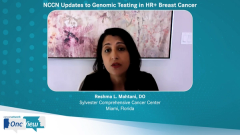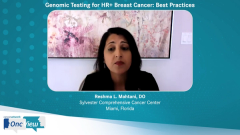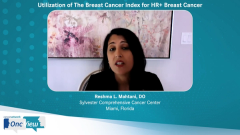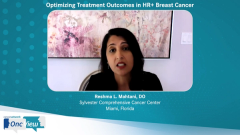
Predictive and Prognostic Factors in HR+ Breast Cancer
Discussion of predictive and prognostic markers used to guide treatment decision-making in HR+ breast cancer.
Episodes in this series

Kristie Kahl: What do we know about which patients might benefit from extended adjuvant therapy and which patients might not?
Vijayakrishna Gadi, MD, PhD: This is more complicated. Conventionally, the tools we had were what the cancer told us, the face value—how much there was at the time of diagnosis, how mean it looked, things like grade 1, 2, and 3. Also, how much in terms of the stage of the tumor itself in the breast, whether it was T1, T2, T3, for example, but also the involvement of the lymph nodes, and the degree of involvement, with N0, N1, N2 designations. Those are typical pathologic clinical factors that any oncologist and any surgical oncologist who has treated the patient can potentially give us, and we can plug those things into a variety of tools, like calculators, to then say, what is the chance that this cancer could come back in the fifth year and beyond?
There was a paper not too long ago by [Hongchao] Pan and colleagues that was published in the New England Journal of Medicine. They looked at tens of thousands of patients who had been treated for early stage breast cancer and then discontinued their antiestrogen therapies at 5 years. They monitored those patients, where they set all those patients back at 0—in terms of them having not recurred—and then monitored them at 5-year intervals to see the things that predicted patients would recur. Any clinical factor that was worse for a patient was prognostic for a recurrence. For example, if you had a larger tumor as opposed to a smaller tumor, you could recur, and you were more likely to recur. If you had node positive vs node negative, you were more likely to recur. If your grade was high vs low, you were more likely to recur. The problem with those prognostications was that they were not necessarily very precise. They were able to say that this group could be at more of a risk than this group, but there were certainly people with high-risk features who did not recur, and there were low-risk features of their initial presentation who did recur. So, it wasn’t completely accurate for us.
Kristie Kahl: You went over a bunch of different types of factors. What is the difference between a predictive and a prognostic factor?
Vijayakrishna Gadi, MD, PhD: Today we’re going to talk about tests and how we use those tests. But for the clinical features, in general what we’re trying to say with prognostic is, “What is the chance that the cancer could come back?” That’s really all that says. Then predictive is, “What’s the chance that an intervention we do—X, Y, or Z, whatever it is—works vs does not work?” What are the tests that can tell us that? Sometimes, the tests are the same: Some can be both prognostic and predictive. Other tests are just prognostic, others are just predictive, and then there are tests that could be both but have not been tested for both types of considerations. In my mind, probably 1 of the oldest prognostic tests we have in breast cancer is simply looking for the estrogen receptor. If you have the estrogen receptor present, on balance, that’s a good feature compared with when it is not present, but it’s also strongly predictive of drugs like tamoxifen and the aromatase inhibitors for working. That’s a very simplistic explanation of a prognostic, predictive distinction. In the world of genomics, these things have taken on a different light, in a different sense. That’s what we’re here to talk about a little more.
Kristie Kahl: What are the predictive and prognostic factors that are associated with extended adjuvant therapy in early stage hormone receptor breast cancer?
Vijayakrishna Gadi, MD, PhD: We highlighted some of these just a moment ago. Some clinical factors that are loosely prognostic, but none of them is predictive at this time. To my knowledge, there’s only 1. There are many prognostic tests. There are even tests from the early stage diagnosis that can say this person could recur as late as 10, 20, 50—whatever number of years down the road. These are generally genomics tests that we can use in early stage breast cancer. But there’s only 1 test, to my knowledge, that has been validated for predicting benefit from antiestrogen therapy in that extended period. That’s known as the BCI [Breast Cancer Index] test. In the parlance of the folks who develop these tests, there is a specific component of that test called the H:I [HOXB13:IL17BR] index, or the H:I ratio. I can go into that in more detail.
Transcript edited for clarity.
Newsletter
Stay up to date on recent advances in the multidisciplinary approach to cancer.







































































































